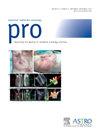Memory Tract Sparing Using Diffusion Tensor Imaging in Radiation Planning of Primary Brain Tumors
IF 3.4
3区 医学
Q2 ONCOLOGY
引用次数: 0
Abstract
Purpose
Radiation therapy (RT) is a critical treatment modality for both primary and metastatic brain tumors, yet ∼30% of patients experience cognitive decline post-RT. This cognitive toxicity is linked to low radiation doses affecting the hippocampal dentate gyrus. Hippocampal avoidance-whole brain RT combined with memantine has shown promising outcomes in preserving cognitive function and quality of life in patients with brain metastases. Nowadays, it is the standard of care for those with good performance status and no hippocampal metastases.
Methods and Materials
We conducted a prospective trial approved by the institutional review board (SMC0307-23), including patients aged ≥18 years with primary brain tumors postresection or biopsy. Exclusion criteria included multifocal glioma crossing to the other hemisphere. RT was delivered to a total dose of 54 Gy in 30 fractions. Diffusion tensor imaging was performed to map hippocampal-associated white matter tracts. Using Eclipse treatment planning software, memory fiber tracts and hippocampi were contoured and integrated into RT planning. Dosimetric analyses compared 2 plans with memory fiber constraints and 1 without. The primary endpoints were safety and dosimetric feasibility.
Results
Twelve patients with low-grade gliomas were included, and the contouring of memory fibers and hippocampi was successful. Volumetric modulated arc therapy (VMAT) treatment plans met-dose constraints for memory fibers, with an average mean dose of 10.1 Gy. The average Montreal Cognitive Assessment score before RT was 27.1 and 26.4 at 8 months post-treatment, with a P value of .07. Excluding 1 patient, the scores were 27.1 and 26.6, respectively (P = .13).
Conclusions
Magnetic resonance imaging planning using diffusion tensor imaging for memory fiber detection and incorporation into RT planning via VMAT techniques enables hippocampal and associated white fiber sparing, potentially preserving cognitive function. Preliminary cognitive data are promising, supporting the need for further validation in a larger cohort.
在原发性脑肿瘤的放射规划中使用弥散张量成像技术疏通记忆束。
简介放射治疗(RT)是治疗原发性和转移性脑肿瘤的重要方法,但约有 30% 的患者在放疗后出现认知能力下降。这种认知毒性与影响海马齿状回的低辐射剂量有关。海马回避(HA)-全脑放疗(WBRT)与美金刚联合治疗在保护脑转移患者的认知功能和生活质量(QOL)方面取得了良好的效果。如今,对于那些表现良好且无海马体转移的患者来说,这已成为标准治疗方法:方法:我们进行了一项经 IRB 批准的前瞻性试验(SMC0307-23),包括年龄在 18 岁及以上的原发性脑肿瘤切除或活检患者。排除标准包括转移至另一半球的多灶性胶质瘤。33例患者的RT总剂量为59.4Gy。弥散张量成像(DTI)用于绘制海马相关白质束。利用Eclipse治疗计划软件,对记忆纤维束和海马进行了轮廓分析,并将其纳入RT计划。剂量学分析比较了两种有记忆纤维限制的计划和一种无记忆纤维限制的计划。主要终点是安全性和剂量可行性:结果:共纳入了12名低级别胶质瘤患者,记忆纤维和海马的轮廓塑造非常成功。VMAT治疗方案符合记忆纤维的剂量限制,平均剂量为10.1 Gy。RT前的平均MoCA评分为27.1分,治疗后八个月为26.4分,P值为0.07。排除一名患者后,得分分别为 27.1 分和 26.6 分(P=0.13):结论:使用DTI进行记忆纤维检测并通过VMAT技术将其纳入RT规划的磁共振成像规划可实现海马及相关白色纤维的保留,从而有可能保留认知功能。初步的认知数据很有希望,但还需要在更大的队列中进一步验证。
本文章由计算机程序翻译,如有差异,请以英文原文为准。
求助全文
约1分钟内获得全文
求助全文
来源期刊

Practical Radiation Oncology
Medicine-Radiology, Nuclear Medicine and Imaging
CiteScore
5.20
自引率
6.10%
发文量
177
审稿时长
34 days
期刊介绍:
The overarching mission of Practical Radiation Oncology is to improve the quality of radiation oncology practice. PRO''s purpose is to document the state of current practice, providing background for those in training and continuing education for practitioners, through discussion and illustration of new techniques, evaluation of current practices, and publication of case reports. PRO strives to provide its readers content that emphasizes knowledge "with a purpose." The content of PRO includes:
Original articles focusing on patient safety, quality measurement, or quality improvement initiatives
Original articles focusing on imaging, contouring, target delineation, simulation, treatment planning, immobilization, organ motion, and other practical issues
ASTRO guidelines, position papers, and consensus statements
Essays that highlight enriching personal experiences in caring for cancer patients and their families.
 求助内容:
求助内容: 应助结果提醒方式:
应助结果提醒方式:


